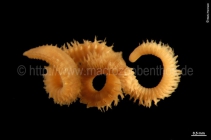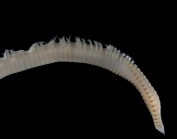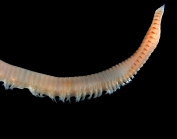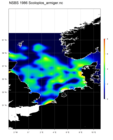WoRMS taxon details
Scoloplos Blainville, 1828
129425 (urn:lsid:marinespecies.org:taxname:129425)
accepted
Genus
Lumbricus armiger Müller, 1776 accepted as Scoloplos armiger (Müller, 1776) (type by monotypy)
Labotas Kinberg, 1866 · unaccepted (subjective synonym)
Scolaricia Eisig, 1914 · unaccepted (subjective synonym)
Scoloplos (Scoloplos) Blainville, 1828 · alternative representation (superseded nominal subgenus)
- Species Scoloplos acmeceps Chamberlin, 1919
- Species Scoloplos armiger (Müller, 1776)
- Species Scoloplos bathytatus Blake, 2017
- Species Scoloplos californiensis Blake, 2020
- Species Scoloplos capensis (Day, 1961)
- Species Scoloplos chrysochaeta Wu, 1962
- Species Scoloplos cryptospinigerus Dean & Blake, 2015
- Species Scoloplos cylindrifer Ehlers, 1904
- Species Scoloplos dayi Hartmann-Schröder, 1980
- Species Scoloplos depoorteri Jeldes & Lefevre, 1959
- Species Scoloplos ehlersi Blake, 1985
- Species Scoloplos haasi (Monro, 1937)
- Species Scoloplos intermedius (Hartman, 1965)
- Species Scoloplos juanfernandezensis Rozbaczylo, Díaz-Díaz & Cataldo, 2017
- Species Scoloplos maranhensis Oliveira, Cutrim, Vieira, Ferreira, Almeida & Nogueira Júnior, 2019
- Species Scoloplos marsupialis Southern, 1921
- Species Scoloplos normalis (Day, 1977)
- Species Scoloplos novaehollandiae (Kinberg, 1866)
- Species Scoloplos papillatus Blake, 2021
- Species Scoloplos pettiboneae Blake, 2021
- Species Scoloplos pseudoarmiger Blake, 2021
- Species Scoloplos pseudosimplex Eibye-Jacobsen, 2002
- Species Scoloplos robustus Rullier, 1964
- Species Scoloplos sagarensis Misra, 1999
- Species Scoloplos similis Mackie, 1987
- Species Scoloplos simplex (Hutchings, 1974)
- Species Scoloplos sparsaciculus Blake, 2020
- Species Scoloplos spiniferus Gallardo, 1968
- Species Scoloplos suroestense Blake, 2017
- Species Scoloplos tumidus Mackie, 1991
- Species Scoloplos typicus (Eisig, 1914)
- Species Scoloplos uschakovi Wu, 1962
- Species Scoloplos verrilli Blake, 2021
- Subgenus Scoloplos (Leodamas) (Kinberg, 1866) accepted as Leodamas Kinberg, 1866 (superseded subsequent subgeneric combination)
- Species Scoloplos (Leodamas) brevithorax Eibye-Jacobsen, 2002 accepted as Leodamas brevithorax (Eibye-Jacobsen, 2002) (superseded original combination)
- Species Scoloplos (Leodamas) chevalieri (Fauvel, 1902) accepted as Leodamas chevalieri (Fauvel, 1902) (superseded recombination, using current genus as subgenus)
- Species Scoloplos (Leodamas) cirratus (Ehlers, 1897) accepted as Leodamas cirratus (Ehlers, 1897) (superseded subsequent combination)
- Species Scoloplos (Leodamas) dendrobranchus Hartman, 1957 accepted as Scoloplos cylindrifer Ehlers, 1904 (subjective synonym)
- Species Scoloplos (Leodamas) dendrocirris Day, 1977 accepted as Leodamas dendrocirris (Day, 1977) (superseded original combination with current genus as subgenus)
- Species Scoloplos (Leodamas) fimbriatus Hartman, 1957 accepted as Leodamas fimbriatus (Hartman, 1957) (superseded original combination)
- Species Scoloplos (Leodamas) gracilis Pillai, 1961 accepted as Leodamas gracilis (Pillai, 1961) (superseded original combination with current genus as subgenus)
- Species Scoloplos (Leodamas) johnstonei Day, 1934 accepted as Leodamas johnstonei (Day, 1934) (superseded subgeneric combination, with current genus as subgenus)
- Species Scoloplos (Leodamas) latum (Chamberlin, 1919) accepted as Leodamas latum (Chamberlin, 1919) (superseded recombination, using current genus as subgenus)
- Species Scoloplos (Leodamas) madagascariensis Fauvel, 1919 accepted as Leodamas madagascariensis (Fauvel, 1919) (superseded subsequent combination)
- Species Scoloplos (Leodamas) marginatus (Ehlers, 1897) accepted as Leodamas marginatus (Ehlers, 1897) (rank upgrade to genus)
- Species Scoloplos (Leodamas) mazatlanensis Fauchald, 1972 accepted as Leodamas mazatlanensis (Fauchald, 1972) (superseded original combination)
- Species Scoloplos (Leodamas) naumovi Averincev, 1982 accepted as Leodamas marginatus (Ehlers, 1897) (subjective synonym)
- Species Scoloplos (Leodamas) ohlini (Ehlers, 1900) accepted as Leodamas cirratus (Ehlers, 1897) (superseded subsequent combination of subjective synonym)
- Species Scoloplos (Leodamas) robustus (Kinberg, 1866) accepted as Leodamas robustus (Kinberg, 1866) (rank upgrade to genus)
- Species Scoloplos (Leodamas) rubra (Webster, 1879) accepted as Leodamas rubrus [auct. misspelling] accepted as Leodamas ruber (Webster, 1879) (superseded recombination, using current genus as subgenus)
- Species Scoloplos (Leodamas) thalassae Amoureux, 1982 accepted as Leodamas thalassae (Amoureux, 1982) (superseded original combination with current genus as subgenus)
- Species Scoloplos (Leodamas) tribulosus (Ehlers, 1897) accepted as Leodamas tribulosus (Ehlers, 1897) (superseded recombination)
- Species Scoloplos (Leodamas) uniramus Day, 1961 accepted as Leodamas johnstonei (Day, 1934) (subjective synonym)
- Species Scoloplos (Leodamas) verax (Kinberg, 1866) accepted as Leodamas verax Kinberg, 1866 (superseded subsequent combination)
- Subgenus Scoloplos (Naidonereis) [auct. misspelling for Naineris] accepted as Naineris Blainville, 1828 (superseded subsequent rank change of misspelling)
- Species Scoloplos (Naidonereis) dubius Augener, 1914 accepted as Paraonis dubius (Augener, 1914) (superseded original combination)
- Species Scoloplos acutissimus Hartmann-Schröder, 1991 accepted as Leodamas acutissimus (Hartmann-Schröder, 1991) (superseded alternate original combination)
- Species Scoloplos acutus (Verrill, 1873) accepted as Leitoscoloplos acutus (Verrill, 1873) (superseded recombination)
- Species Scoloplos agrestis Nonato & Luna, 1970 accepted as Leodamas agrestis (Nonato & Luna, 1970) (superseded original combination)
- Species Scoloplos brevithorax Eibye-Jacobsen, 2002 accepted as Leodamas brevithorax (Eibye-Jacobsen, 2002) (superseded recombination, subgeneric rank abandoned)
- Species Scoloplos bustorus Eisig, 1914 accepted as Leitoscoloplos robustus (Verrill, 1873) (subjective synonym)
- Species Scoloplos canadensis McIntosh, 1901 accepted as Scoloplos armiger (Müller, 1776) (subjective synonym)
- Species Scoloplos chevalieri (Fauvel, 1901) accepted as Leodamas chevalieri (Fauvel, 1902) (superseded recombination)
- Species Scoloplos cirrata (Treadwell, 1901) accepted as Leodamas treadwelli (Eisig, 1914) (subsequent combination of a replaced primary homonym)
- Species Scoloplos dubia Tebble, 1955 accepted as Leodamas dubius (Tebble, 1955) (superseded original combination, mandatory correction to 'dubius')
- Species Scoloplos dubius Tebble, 1953 accepted as Leodamas dubius (Tebble, 1955) (superseded original combination, but unavailable as primary junior homonym)
- Species Scoloplos elongata Johnson, 1901 accepted as Leitoscoloplos pugettensis (Pettibone, 1957) (replaced primary homonym; incorrect gender suffix ending)
- Species Scoloplos elongatus Quatrefages, 1866 accepted as Scoloplos armiger (Müller, 1776) (subjective synonym)
- Species Scoloplos fragilis (Verrill, 1873) accepted as Leitoscoloplos fragilis (Verrill, 1873) (superseded recombination)
- Species Scoloplos grubei Gravier, 1908 accepted as Naineris grubei (Gravier, 1908) (superseded original combination)
- Species Scoloplos jeffreysii McIntosh, 1905 accepted as Scoloplos armiger (Müller, 1776) (subjective synonym)
- Species Scoloplos johnstonei Day, 1934 accepted as Leodamas johnstonei (Day, 1934) (superseded original combination)
- Species Scoloplos kerguelensis McIntosh, 1885 accepted as Leitoscoloplos kerguelensis (McIntosh, 1885) (superseded original combination)
- Species Scoloplos latus (Chamberlin, 1919) accepted as Leodamas latum (Chamberlin, 1919) (superseded subsequent combination, with gender suffix ending changed)
- Species Scoloplos madagascarensis Fauvel, 1919 accepted as Leodamas madagascariensis (Fauvel, 1919) (superseded alternate spelling)
- Species Scoloplos madagascariensis Fauvel, 1919 accepted as Leodamas madagascariensis (Fauvel, 1919) (superseded original combination)
- Species Scoloplos marginatus (Ehlers, 1897) accepted as Leodamas marginatus (Ehlers, 1897) (superseded subsequent combination)
- Species Scoloplos mawsoni Benham, 1921 accepted as Leitoscoloplos mawsoni (Benham, 1921) (superseded original combination)
- Species Scoloplos minor Örsted, 1842 accepted as Naineris quadricuspida (Fabricius, 1780) (subjective synonym)
- Species Scoloplos quadricuspida (Fabricius, 1780) accepted as Naineris quadricuspida (Fabricius, 1780) (unaccepted > superseded combination, superseded subsequent combination)
- Species Scoloplos rufa Treadwell, 1941 accepted as Leitoscoloplos robustus (Verrill, 1873) (subjective synonym)
- Species Scoloplos texana Maciolek & Holland, 1978 accepted as Leodamas texana (Maciolek & Holland, 1978) (superseded original combination)
- Species Scoloplos thalassae Amoureux, 1982 accepted as Leodamas thalassae (Amoureux, 1982) (superseded original combination with subgeneric rank abandoned)
- Species Scoloplos treadwelli Eisig, 1914 accepted as Leodamas treadwelli (Eisig, 1914) (superseded original replacement name)
- Subgenus Scoloplos (Scoloplos) Blainville, 1828 represented as Scoloplos Blainville, 1828 (superseded nominal subgenus)
- Species Scoloplos (Scoloplos) acmeceps Chamberlin, 1919 accepted as Scoloplos acmeceps Chamberlin, 1919 (alternate representation of original combination)
- Species Scoloplos (Scoloplos) acutissimus Hartmann-Schröder, 1991 accepted as Leodamas acutissimus (Hartmann-Schröder, 1991) (superseded original combination)
- Species Scoloplos (Scoloplos) armiger (Müller, 1776) accepted as Scoloplos armiger (Müller, 1776) (superseded nominal subgenus)
- Species Scoloplos (Scoloplos) capensis (Day, 1961) accepted as Scoloplos capensis (Day, 1961) (subgeneric rank abandoned)
- Species Scoloplos (Scoloplos) dayi Hartmann-Schröder, 1980 accepted as Scoloplos dayi Hartmann-Schröder, 1980 (original alternate representation)
- Species Scoloplos (Scoloplos) dayi Pettibone, 1957 accepted as Scolaricia dubia (Day, 1955) (objective synonym)
- Species Scoloplos (Scoloplos) difficilis Day, 1977 accepted as Scoloplos simplex (Hutchings, 1974) (subjective synonym)
- Species Scoloplos (Scoloplos) ehlersi Blake, 1985 accepted as Scoloplos ehlersi Blake, 1985 (unaccepted > superseded rank, nominal subgenus no longer required)
- Species Scoloplos (Scoloplos) marsupialis Southern, 1921 accepted as Scoloplos marsupialis Southern, 1921 (unaccepted > superseded rank, nominal subgenus no longer required)
- Species Scoloplos (Scoloplos) pseudosimplex Eibye-Jacobsen, 2002 accepted as Scoloplos pseudosimplex Eibye-Jacobsen, 2002 (superseded original combination, subgeneric rank abandoned)
- Species Scoloplos (Scoloplos) pugettensis Pettibone, 1957 accepted as Leitoscoloplos pugettensis (Pettibone, 1957) (superseded original combination)
- Species Scoloplos (Scoloplos) riseri Pettibone, 1957 accepted as Orbinia riseri (Pettibone, 1957) (superseded original combination)
- Species Scoloplos (Scoloplos) schmitti Pettibone, 1957 accepted as Califia schmitti (Pettibone, 1957) (superseded original combination)
- Species Scoloplos (Scoloplos) simplex (Hutchings, 1974) accepted as Scoloplos simplex (Hutchings, 1974) (unaccepted alternate representation)
- Species Scoloplos (Scoloplos) spiniferus Gallardo, 1968 accepted as Scoloplos spiniferus Gallardo, 1968 (unaccepted > superseded rank, nominal subgenus no longer required)
- Species Scoloplos (Scoloplos) texana Maciolek & Holland, 1978 accepted as Leodamas texana (Maciolek & Holland, 1978) (superseded combination (using nominal subgenus))
- Species Scoloplos rubra (Webster, 1879) represented as Scoloplos (Leodamas) rubra (Webster, 1879) accepted as Leodamas rubrus [auct. misspelling] accepted as Leodamas ruber (Webster, 1879)
marine, brackish, fresh, terrestrial
recent only
masculine
Blainville, H. M. D de [Henri-Marie Ducrotay]. (1828). Mollusques, Vers et Zoophytes <b>[entries in VEA-VERS, volume 57]</b>. <em>In: Dictionnaire des Sciences naturelles, dans lequel on traite méthodiquement des différens êtres de la nature, considérés soit en eux-memês, d'après l'état actuel de nos connoissances, soit relativement à l'utilité qu'en peuvent retirer la médicine, l'agriculture, le commerce et les arts. Suive d'une biographie des plus célèbres naturalistes.</em> vol. 57 [Tome LVII. Vea - Vers] F.G. Levrault, Strasbourg & Paris., available online at https://biodiversitylibrary.org/page/25316522
page(s): 493 [details]
page(s): 493 [details]
Etymology Not stated in the original description. The generic name Scoloplos is from the Greek, a masculine word referring to...
description ORBINIINAE with pointed prostomium and branchiae first present from setiger 5 or later. Accessory papillae never exceeding...
Etymology Not stated in the original description. The generic name Scoloplos is from the Greek, a masculine word referring to anything pointed, or a thorn, and might thus refer either to the characteristic pointed head, or to the spiny bristles referred in the original decription: ''Appendices [...] des dix-sept premiers [segments] formés probablement de deux soies épineuses de chaque côté'' (Blainville, 1828: 493). [details]
description ORBINIINAE with pointed prostomium and branchiae first present from setiger 5 or later. Accessory papillae never exceeding...
description ORBINIINAE with pointed prostomium and branchiae first present from setiger 5 or later. Accessory papillae never exceeding four, including both ventral and parapodial kinds. Thoracic neurosetae include blunt hooks and crenulated capillaries (may be absent). Abdominal notosetae include crenulated capillaries, furcate setae and spines. [details]
Read, G.; Fauchald, K. (Ed.) (2025). World Polychaeta Database. Scoloplos Blainville, 1828. Accessed through: World Register of Marine Species at: https://www.marinespecies.org/aphia.php?p=taxdetails&id=129425 on 2025-07-18
Date
action
by
![]() The webpage text is licensed under a Creative Commons
Attribution 4.0 License
The webpage text is licensed under a Creative Commons
Attribution 4.0 License
Nomenclature
original description
Blainville, H. M. D de [Henri-Marie Ducrotay]. (1828). Mollusques, Vers et Zoophytes <b>[entries in VEA-VERS, volume 57]</b>. <em>In: Dictionnaire des Sciences naturelles, dans lequel on traite méthodiquement des différens êtres de la nature, considérés soit en eux-memês, d'après l'état actuel de nos connoissances, soit relativement à l'utilité qu'en peuvent retirer la médicine, l'agriculture, le commerce et les arts. Suive d'une biographie des plus célèbres naturalistes.</em> vol. 57 [Tome LVII. Vea - Vers] F.G. Levrault, Strasbourg & Paris., available online at https://biodiversitylibrary.org/page/25316522
page(s): 493 [details]
original description (of Scolaricia Eisig, 1914) Eisig, Hugo. (1914). Zur Systematik, Anatomie und Morphologie der Ariciiden nebst Beiträgen zur generellen Systematik. <em>Mitteilungen aus der Zoologischen Station zu Neapel.</em> 21(6): 153-600, plates 10-27., available online at https://biodiversitylibrary.org/page/47117118
page(s): 426 [details]
original description (of Labotas Kinberg, 1866) Kinberg, J. G. H. (1866). Annulata Nova. Continuatio. [various errantia & sedentaria]. <em>Öfversigt af Königlich Vetenskapsakademiens förhandlingar, Stockholm.</em> 22(4): 239-258., available online at https://biodiversitylibrary.org/page/32339515
page(s): 252 [details]
page(s): 493 [details]
original description (of Scolaricia Eisig, 1914) Eisig, Hugo. (1914). Zur Systematik, Anatomie und Morphologie der Ariciiden nebst Beiträgen zur generellen Systematik. <em>Mitteilungen aus der Zoologischen Station zu Neapel.</em> 21(6): 153-600, plates 10-27., available online at https://biodiversitylibrary.org/page/47117118
page(s): 426 [details]
original description (of Labotas Kinberg, 1866) Kinberg, J. G. H. (1866). Annulata Nova. Continuatio. [various errantia & sedentaria]. <em>Öfversigt af Königlich Vetenskapsakademiens förhandlingar, Stockholm.</em> 22(4): 239-258., available online at https://biodiversitylibrary.org/page/32339515
page(s): 252 [details]
Taxonomy
taxonomy source
Blake, James A. (2017). Polychaeta Orbiniidae from Antarctica, the Southern Ocean, the Abyssal Pacific Ocean, and off South America. <em>Zootaxa.</em> 4218(1): 1-145 [monograph]., available online at http://www.biotaxa.org/Zootaxa/article/view/zootaxa.4218.1.1/25653
page(s): 43; note: genus restricted to species having only inconspicuous spines in thoracic neuropodia accompanied with numerous capillaries, and branchiae from setiger 8–26 [details] Available for editors [request]
[request]
page(s): 43; note: genus restricted to species having only inconspicuous spines in thoracic neuropodia accompanied with numerous capillaries, and branchiae from setiger 8–26 [details] Available for editors
Identification resource
identification resource
Oliveira, Verônica M.; Cutrim, Allana S.T.; Vieira, Anna Karen M.; Ferreira, Camila N.; Almeida, Zafira S.; Nogueira Júnior, Miodeli. (2019). Description of <i>Scoloplos maranhensis</i> sp. nov. (Orbiniidae, Annelida) from tropical Brazilian mangrove. <em>Iheringia, Série Zoologia.</em> 109 (e2019009): 1-10., available online at https://doi.org/10.1590/1678-4766e2019009
page(s): table I; note: synoptic table of currently known species [details] Available for editors [request]
[request]
page(s): table I; note: synoptic table of currently known species [details] Available for editors
Other
additional source
Fauchald, K. (1977). The polychaete worms, definitions and keys to the orders, families and genera. <em>Natural History Museum of Los Angeles County: Los Angeles, CA (USA), Science Series.</em> 28:1-188., available online at http://www.vliz.be/imisdocs/publications/123110.pdf [details]
additional source Bellan, G. (2001). Polychaeta, <i>in</i>: Costello, M.J. <i>et al.</i> (Ed.) (2001). European register of marine species: a check-list of the marine species in Europe and a bibliography of guides to their identification. <em>Collection Patrimoines Naturels.</em> 50: 214-231. (look up in IMIS) [details]
additional source Brunel, P., L. Bosse & G. Lamarche. (1998). Catalogue of the marine invertebrates of the estuary and Gulf of St. Lawrence. <em>Canadian Special Publication of Fisheries and Aquatic Sciences, 126.</em> 405 pp. (look up in IMIS) [details] Available for editors [request]
[request]
additional source Day, J. H. (1967). [Sedentaria] A monograph on the Polychaeta of Southern Africa. Part 2. Sedentaria. British Museum (Natural History), London. pp. 459–842., available online at http://www.biodiversitylibrary.org/bibliography/8596 [details]
additional source Glasby, Christopher J.; Read, Geoffrey B.; Lee, Kenneth E.; Blakemore, R.J.; Fraser, P.M.; Pinder, A.M.; Erséus, C.; Moser, W.E.; Burreson, E.M.; Govedich, F.R.; Davies, R.W.; Dawson, E.W. (2009). Phylum Annelida: bristleworms, earthworms, leeches. <em>[Book chapter].</em> Chapt 17, pp. 312-358. in: Gordon, D.P. (Ed.) (2009). New Zealand inventory of biodiversity: 1. Kingdom Animalia: Radiata, Lophotrochozoa, Deuterostomia. Canterbury University Press, Christchurch. [details] Available for editors [request]
[request]
additional source Bellan, G. (2001). Polychaeta, <i>in</i>: Costello, M.J. <i>et al.</i> (Ed.) (2001). European register of marine species: a check-list of the marine species in Europe and a bibliography of guides to their identification. <em>Collection Patrimoines Naturels.</em> 50: 214-231. (look up in IMIS) [details]
additional source Brunel, P., L. Bosse & G. Lamarche. (1998). Catalogue of the marine invertebrates of the estuary and Gulf of St. Lawrence. <em>Canadian Special Publication of Fisheries and Aquatic Sciences, 126.</em> 405 pp. (look up in IMIS) [details] Available for editors
additional source Day, J. H. (1967). [Sedentaria] A monograph on the Polychaeta of Southern Africa. Part 2. Sedentaria. British Museum (Natural History), London. pp. 459–842., available online at http://www.biodiversitylibrary.org/bibliography/8596 [details]
additional source Glasby, Christopher J.; Read, Geoffrey B.; Lee, Kenneth E.; Blakemore, R.J.; Fraser, P.M.; Pinder, A.M.; Erséus, C.; Moser, W.E.; Burreson, E.M.; Govedich, F.R.; Davies, R.W.; Dawson, E.W. (2009). Phylum Annelida: bristleworms, earthworms, leeches. <em>[Book chapter].</em> Chapt 17, pp. 312-358. in: Gordon, D.P. (Ed.) (2009). New Zealand inventory of biodiversity: 1. Kingdom Animalia: Radiata, Lophotrochozoa, Deuterostomia. Canterbury University Press, Christchurch. [details] Available for editors
 Present
Present  Inaccurate
Inaccurate  Introduced: alien
Introduced: alien  Containing type locality
Containing type locality
From editor or global species database
Diagnosis Original diagnosis by Blainville (1828: 493): ''Corps alongé, cylindrique, atténué aux extrémités, et composé d'un grand nombre d'articulations. Bouche et anus terminaux à l'extrémité de segmens non modifiés. Appendices dissemblables. Ceux des dix-sept premiers formés probablement de deux soies épineuses de chaque côté, les autres composés: 1.° D'une sorte de renflement costiforme, proéminent et terminé inférieurement par une verrue bifide; 2.° D'une soie simple et courte; 3.° D'une lamelle lancéolée et arquée.''[details]
Etymology Not stated in the original description. The generic name Scoloplos is from the Greek, a masculine word referring to anything pointed, or a thorn, and might thus refer either to the characteristic pointed head, or to the spiny bristles referred in the original decription: ''Appendices [...] des dix-sept premiers [segments] formés probablement de deux soies épineuses de chaque côté'' (Blainville, 1828: 493). [details]
Grammatical gender Masculine. Scoloplos is masculine in Greek and most authors have used masculine adjectives with it. [details]
Unreviewed
description ORBINIINAE with pointed prostomium and branchiae first present from setiger 5 or later. Accessory papillae never exceeding four, including both ventral and parapodial kinds. Thoracic neurosetae include blunt hooks and crenulated capillaries (may be absent). Abdominal notosetae include crenulated capillaries, furcate setae and spines. [details]
To European Nucleotide Archive, ENA (Scolaricia) (from synonym Scolaricia Eisig, 1914)
To European Nucleotide Archive, ENA (Scoloplos)
To Genbank (from synonym Scolaricia Eisig, 1914)
To Genbank
To The Arctic Traits Database (0 traits) (from synonym Scoloplos (Scoloplos) Blainville, 1828)
To The Arctic Traits Database (5 traits)
To ITIS
To European Nucleotide Archive, ENA (Scoloplos)
To Genbank (from synonym Scolaricia Eisig, 1914)
To Genbank
To The Arctic Traits Database (0 traits) (from synonym Scoloplos (Scoloplos) Blainville, 1828)
To The Arctic Traits Database (5 traits)
To ITIS




